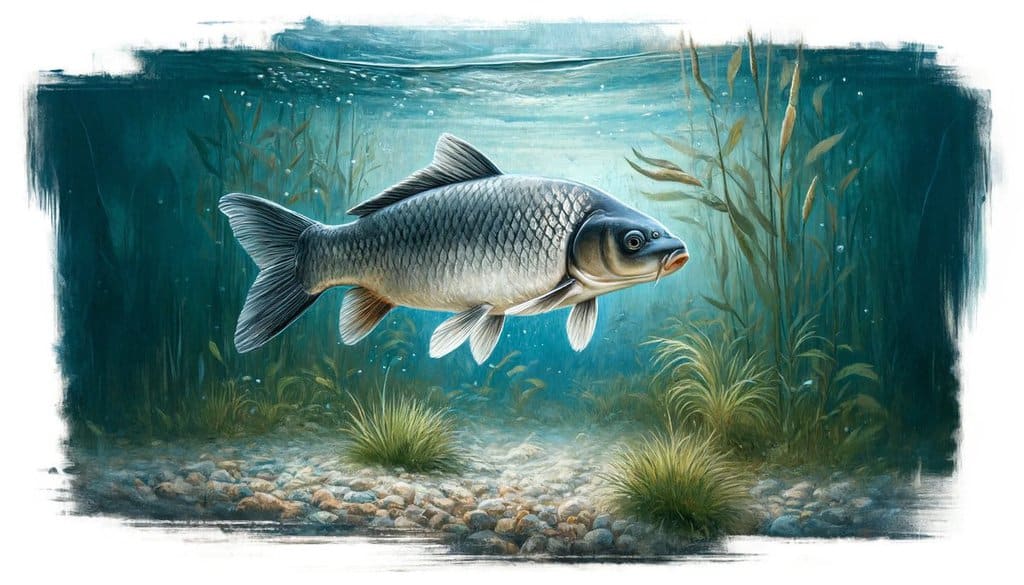The Silver carp (Hypophthalmichthys molitrix) is a popular species in aquaculture due to its rapid growth rate, efficient feed conversion, and ability to filter phytoplankton from water[1][2]. While not traditionally used in aquaponics, its potential for water quality improvement and high productivity makes it an interesting candidate for certain systems.
Natural Habitat and Behavior
Origin and native environment: Silver carp are native to eastern Asia, typically inhabiting freshwater environments such as large rivers and lakes[1].
Natural behavior in the wild: They are known for their jumping behavior, often breaching the water surface when disturbed[1]. Silver carp are schooling fish and typically more active during the day[1].
Temperament: Generally peaceful, but their large size and jumping behavior may cause issues in confined spaces.
Compatibility: Due to their size and specific feeding habits, silver carp are best kept in species-specific systems or with other large, non-predatory fish.
Water Requirements
Temperature Range:
- Ideal temperature: 6-28°C (42.8-82.4°F)[1]
- Optimal spawning temperature: 22-28°C (71.6-82.4°F)[1]
pH Level: Silver carp can tolerate a wide range of pH levels. Keeping your pH around 6.5-7 would be ideal for your aquaponics plants.
Water hardness: Information not provided in the search results.
Oxygen Levels: Can tolerate low dissolved oxygen content (3 mg/l)[1].
Ammonia/Nitrate Sensitivity: Specific sensitivity levels are not mentioned, but as most fish, keeping ammonia and nitrite as close to 0 as possible is never wrong.
Tank or Pond Setup
Tank/Pond Size Requirements: Due to their large size (up to 1.5 m or 4.9 ft) and schooling behavior, silver carp require substantial space[2]. A large pond or tank system would be preferred for aquaponics.
Filtration & Aeration: As filter feeders, silver carp can help improve water quality some, but additional mechanical and biological filtration is necessary, size depends on stocking density[1].
Lighting Considerations: Any light is sufficient; a natural day-night cycle is preferred as they are more active during the daytime.
Tank Decorations/Substrate: Silver carp prefer open water environments without vegetation[2].
Feeding Requirements
Diet: Silver carp are filter feeders, primarily consuming phytoplankton[1](green water). Their specialized gill rakers allow them to filter particles ranging from 8 to 100 micrometers in size[1]. A separate greenwater propagation tank to supply your fish would be preferred.
Feeding Techniques: In aquaponics systems, supplemental feeding with fine particulate matter or specially formulated feeds may be necessary if natural phytoplankton levels are insufficient.
Growth and Reproduction
Growth Rate: Silver carp grow rapidly, reaching 8 to 12 cm (3.1 to 4.7 inches) in body length after about 5 months[1].
Physical Growth Indicators: Adults can reach over 1.5 m (4.9 ft) in length and weigh over 60 kg (132 lbs)[2].
Breeding Behavior:
- Sexual maturity: 4 to 6 years of age[1]
- Spawning occurs in spring or summer, typically upstream in rivers[1]
- Optimal spawning temperature: 22-28°C (71.6-82.4°F)[1]
Care of Fry: Eggs hatch after about 68 hours, and fry are vulnerable and inefficient feeders initially[1].
Harvesting & Culinary Considerations
Growth to Harvest: Silver carp can grow quite large and may live up to 20 years in the wild[1].
Culinary Uses: Known for its high protein content and rich in polyunsaturated fatty acids, lipid-soluble vitamins, and micronutrients[2].
Pros and Cons
- Efficient at filtering phytoplankton, potentially improving water quality[1]
- Rapid growth rate[2]
- High feed efficiency ratio[2]
- Large size may be challenging for smaller aquaponics setups
- Jumping behavior could pose management issues[1]
- May require specialized feeding strategies in aquaponics systems
Overall Suitability: Best suited for large-scale aquaponics operations or experienced practitioners with adequate space and resources.
Common Health Issues and Solutions
Potential Diseases: Specific disease information for aquaponics systems is not mentioned.
Maintenance Tips for Long-Term Health
Maintenance Frequency: Regular monitoring of water quality parameters is always a good thing, keeping ammonia and nitrites low, and water temperatures and pH stable is always a plus.
System checks: Monitor temperature, dissolved oxygen, and phytoplankton levels regularly.
Handling Practices: Minimize handling to reduce stress and prevent jumping injuries.
Final words
I think silver carp present unique challenges and opportunities for aquaponics. Their efficient filtration capabilities and rapid growth make them interesting candidates for large-scale systems, but their size and specific feeding requirements demand careful consideration and management. If you plan on growing and feeding green water(phytoplankton) this would also create another step and extra system for you to manage and make room for.
Maybe check out some other fish species for aquaponics
External sources:
[1] https://animaldiversity.org/accounts/Hypophthalmichthys_molitrix/
[2] https://www.ncbi.nlm.nih.gov/pmc/articles/PMC9605455/
[3] https://www.ncbi.nlm.nih.gov/pmc/articles/PMC6436794/
[4] https://www.fao.org/fishery/docs/CDrom/aquaculture/I1129m/file/en/en_silvercarp.htm
[5] https://thefishsite.com/articles/cultured-aquatic-species-silver-carp
[6] https://www.ncbi.nlm.nih.gov/pmc/articles/PMC11018436/

